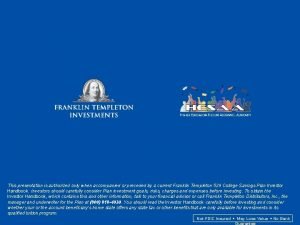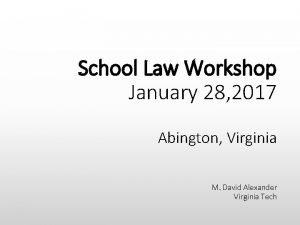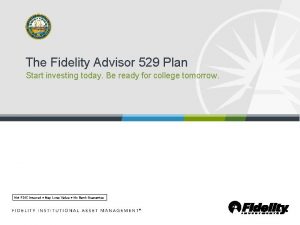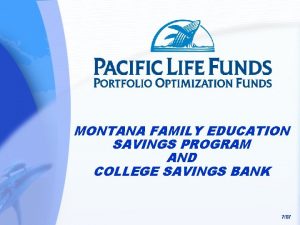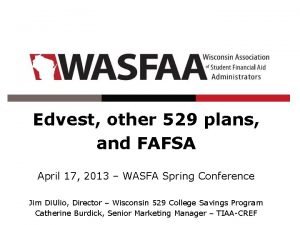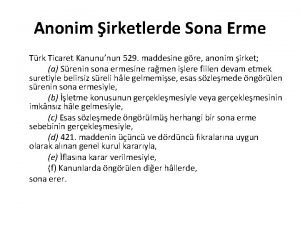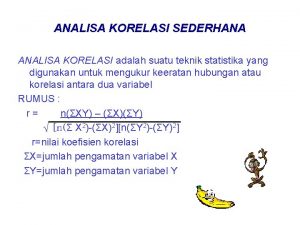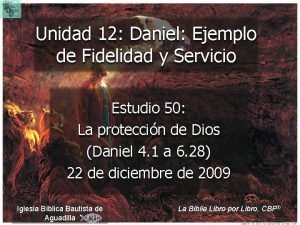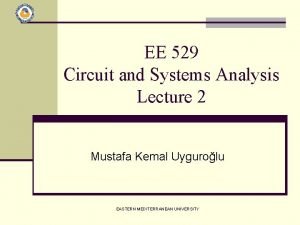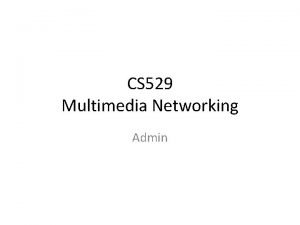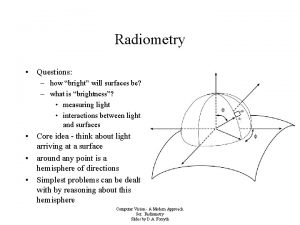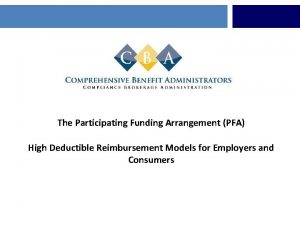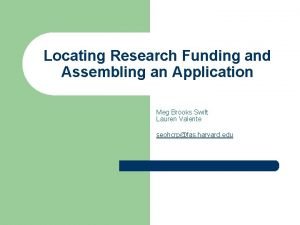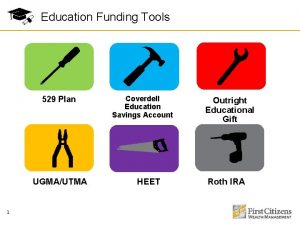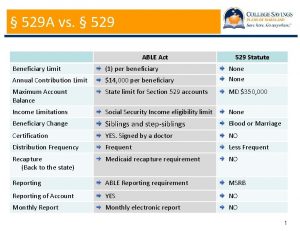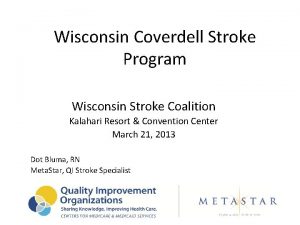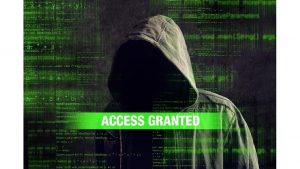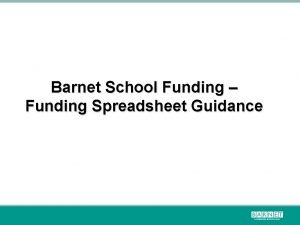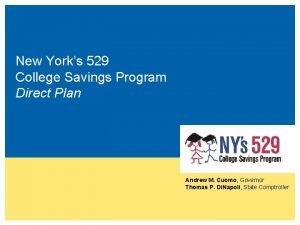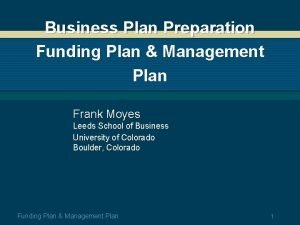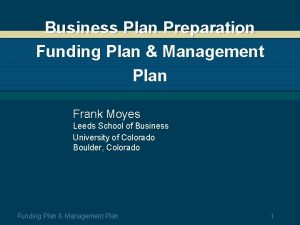Education Funding Tools 529 Plan UGMAUTMA 1 Coverdell





















- Slides: 21

Education Funding Tools 529 Plan UGMA/UTMA 1 Coverdell Education Savings Account HEET Outright Educational Gift Roth IRA

Section 529 Plans Types of 520 Plans § Prepaid tuition plans § College Savings Plans Beneficiary § You can choose anyone – child, relative, friend, etc. § You can reallocate the account to a different family member (if a child cannot or chooses not to attend college) § There is no age limitation on when to use funds (for Coverdell it is age 30) 2

Section 529 Plans How Much Can you Invest? § Limits vary per state; some states in excess of $300, 000 § Can contribute as little as $25 Tax Treatment § Qualified withdrawals are federally tax-free (tuition, room and board, fees, books, supplies and equipment). Contributions may be deductible for state income tax § Some states offer an income tax deduction for contributions to a 529 plan § May rollover once a year § May rollover into an ABLE account Gift and Estate Tax benefits 3 § Can contribute as much as five times the current annual exclusion for gift tax in one year without triggering gift taxes § Contributions are considered completed gifts and may be removed from contributor’s estate

Section 529 Plans Who Controls the Account? § The account owner (donor) § The account owner is the only person who can authorize a distribution from the account—so you know your savings will go toward education expenses Restrictions on Using the Money § Withdrawals must be used for qualified higher education expenses § If not, earnings are subject to a 10% penalty plus income taxes Impact on Financial Aid § May not affect financial aid qualifications. Account is considered an asset of the account owner (donor), not the beneficiary. § Does not affect eligibility for a Hope Scholarship Credit or Lifetime Learning Credit 4

Section 529 Plans Disadvantages § A portion of your lifetime applicable exclusion may be used to shelter these gifts. The full amount gifted may not be covered by annual exclusion gifts. § Funds are limited to qualified educational expenses. If the funds are not used for a qualified expense, taxable income on the gain is incurred and a 10% additional penalty applies. Additional Information § Can be used for International schools if they have a federal school code on FAFSA (there are 100 that currently have one) 5

Coverdell Education Savings Account Sometimes called the Education IRA How Much Can you Invest? § $2, 000 maximum annual per beneficiary Tax Treatment § Earnings are tax-free if used for the student’s qualified education expenses (tuition, room and board, computers, books and supplies, tutoring, transportation) § No current income tax deduction for contributions Gift and Estate Tax benefits 6 § Contributions are considered completed gifts and may be removed from contributor’s estate § Contributions may be made to both a Coverdell ESA and a Section 529 plan in one calendar year. However, if the combined contributions exceed the current annual exclusion for gift tax, or twice that amount if gift-splitting is elected, there may be gift tax implications to consider

Coverdell Education Savings Account Who Controls the Account § The owner is the person who sets up the account (not the beneficiary) § The owner affects FAFSA: § Child is owner and beneficiary and dependent – not counted § Child is owner and beneficiary and independent – 20% is counted § Parent is owner – 5. 64% is counted § Grandparent (or other) is owner – not counted Restrictions on Using the Money § Withdrawals must be used for qualified elementary, secondary, or higher education school expenses, otherwise earnings are taxed and may be subject to a 10% penalty Impact on Financial Aid § Participation in financial aid and tuition repayment programs may be affected 7

Coverdell Education Savings Accounts Disadvantages § Your ability to contribute depends on your income--to make the full $2, 000 contribution, single filers must have a modified adjusted gross income (MAGI) of $95, 000 or less (a partial contribution is allowed if MAGI is between $95, 000 and $110, 000) and joint filers must have a MAGI of $190, 000 or less (a partial contribution is allowed if MAGI is between $190, 000 and $220, 000) § Contributions aren't allowed after the beneficiary reaches age 18, unless the beneficiary has special needs. Unused accounts can be rolled over to a family member of the beneficiary. § The account must be closed after the beneficiary reaches age 30, unless the beneficiary has special needs 8

Outright Gift How Much Can you Invest? § Unlimited payments if made directly to the educational institution Tax Treatment § No income tax deductions Gift and Estate Tax benefits § No annual exclusion gifting is required § Removes the value of the gift from your taxable estate § None of your applicable lifetime gift tax exclusion is used 9

Outright Gift Who Controls the Account? § Donor controls how much they give under section 2503(e) Restrictions on Using the Money § Payments are limited to direct payments of tuition and fees (may not be used for books, room, board, etc. ) Impact on Financial Aid § May reduce financial aid available to the student § Depends on the income and asset base of the student’s parents 10

Outright Gift Disadvantages § You will not receive as many tax benefits as the previous plans § Your gifts may affect your child or grandchild’s financial aid eligibility § You don’t get any tax benefits for investing funds 11

UGMA & UTMA Accounts Uniform Gift to Minors Act Accounts (UGMAs) Uniform Transfer to Minors Act Accounts (UTMAs) § Allow you to invest assets under a child's name with an adult as custodian § Irrevocable § Minor differences in UGMA vs UTMA – usually age of majority, type of investments (UGMA is more limited to basic assets) § By law, minors (those under the age of 18 to 21, depending on your state) generally cannot own securities, including mutual fund shares, outright § UGMAs and UTMAs are vehicles that allow minors to enjoy the benefits of owning securities within the limits of the law. § They distribute out at age of majority: 12 o o o NC – UTMA 21 y/o SC – UGMA 18 or 21 y/o VA – UTMA 18 y/o FL – UTMA 18, some 21 y/o GA – UTMA 18, some 21 y/o

UGMA & UTMA Account How Much Can you Invest? § Unlimited contributions Tax Treatment § A portion of earnings are tax-free ($2, 100 for 2017) § The portion that exceeds $2, 100 is subject to the Kiddie Tax. TCJA changed the Kiddie Tax rates to that of a single taxpayer (sunsets in 2026) Gift and Estate Tax benefits § Contributions are considered completed gifts for estate tax purposes § However, if the donor is the custodian and dies prior to the child’s age of majority, the account may be included in the taxable estate 13

UGMA & UTMA Account Who Controls the Account? § Any concerned adult—a grandparent, aunt, uncle, or godparent, for example— can establish an UGMA or UTMA account § Child may assume control of the account once the custodianship terminates. Restrictions on Using the Money § Withdrawals can pay for higher education, but also may be made for noneducational needs of the child. § When the child reaches the age when custodianship terminates, he or she takes complete control of the assets and can use them for any purpose. Impact on Financial Aid § As the account belongs to student beneficiary, the funds are deemed to be completely available to defray educational expenses § Eligibility depends on the income and asset base of the student’s parents 14

UGMA & UTMA Account Disadvantages § Assets Might Not Be Used for College: Once the child takes control of the account, the child might use the money for purposes other than education— regardless of the custodian's wishes § Assets Are Included in the Taxable Estate: If the parent is serving as custodian and dies before the beneficiary has reached the age of majority, the account will be included in the parent’s gross estate. After the beneficiary reaches majority, the assets belong to the beneficiary and will not be included. 15

Health & Education Exclusion Trust (HEET) A Health and Education Exclusion Trust (HEET) is used to transfer wealth to younger generations to fund family members’ education and medical expenses Benefits § When used for qualifying expenses, the money transfer is free from estate, gift and generation-skipping transfer taxes § Once funded, the Trustee for the HEET can pay, on a beneficiary’s behalf, and unlimited amount of qualified education expenses and qualified medical expenses. Considerations § To avoid generation-skipping transfer tax - a charity, including a private foundation, must be a mandatory income beneficiary (10%) to part of the HEET income § Distributions from the HEET must be made directly to educational or medical providers to pay for qualified expenses. Any other distribution, either to a beneficiary or for nonqualified expenses, would be subject to generation-skipping transfer taxes. 16 § The Trust should make distributions for unreimbursed qualified medical expenses only. If trust assets are used to fund expenses that are later covered by insurance, these distributions will be subject to generation-skipping tax.

HEET Trust Educational Expenses § Payment of tuition, in any amount, for full or part time students attending primary, secondary, undergraduate, or post graduate education programs. § The educational institution need not be accredited and includes art, literary, trade or similar education programs. Medical Expenses § The IRS defines qualified medical expenses as payments, in any amount, that are made to any person who renders services to the beneficiary for the purpose of diagnosis, cure, mitigation, treatment, or prevention of disease or for the purpose of affecting any structure or function of the body or for transportation primarily for and essential to medical care. § Qualified medical expenses also include the purchase of health insurance and long-term care insurance for family members. 17

Roth IRA Although technically a retirement account, Roth IRAs have some features that make them an effective college saving tool Benefits § 100% tax-free withdrawals once you reach age 59½ (taxed and penalized before then) § You can withdraw the amount you contributed (not the appreciation) at any time without penalty and tax-free § You can withdraw the earnings anytime penalty-free (but not tax-free) if the money is used for college expenses for you, your spouse, your children or your grandchildren Additional Considerations § Offers flexibility – you can decide later if you want your savings to be used for retirement or college education. This helps if you are not sure your child will even go to college § Roth IRAs are not counted on FAFSA (less than the 5% for 529 Plans) § Wider variety of investment opportunities than 529 plans 18

Roth IRA Disadvantages § Withdrawals are not tax-free until the owner is 59½ § Some states offer income tax deductions for 529 contributions. Roth IRA contributions are always after-tax § Withdrawals (not assets in the account) from a Roth IRA are counted on the FAFSA form, even if the money isn’t taxed as income § Roth IRAs have restrictive contribution limits § You use up your retirement account space for education purposes (you might need it) 19

Education Plan Tools Comparison 529 College Savings Plan Coverdell Education Savings Account Outright Educational Gift UGMA/UTMA How much can you invest? Limits vary per state; some states in excess of $2, 000 maximum annual $300, 000. per beneficiary. Unlimited payments if made directly to the educational institution. Unlimited contributions. Tax treatment Earnings grow tax-deferred. Qualified withdrawals are federally tax-free. Contributions may be deductible for state income tax. Earnings are tax-free if used for the student’s qualified education expenses. N/A A portion of earnings are tax-free. Another portion may be taxable at the child’s rate, which is usually lower than an adult’s. “Kiddie Tax” may apply. Who controls the account? The account owner (donor). Responsible individual maintains control of the account until all assets are distributed. N/A Child may assume control of the account once the custodianship terminates. Gift and Estate Tax Benefits Can contribute as much as five times the current annual exclusion for gift tax in one year without triggering gift taxes. Contributions are considered completed gifts and may be removed from contributor’s estate. Contributions are considered completed gifts for estate tax purposes. Unlimited in amount if made directly to the educational institution. Payments are not includible in the donor’s estate. Contributions are considered completed gifts for estate tax purposes. However, if the donor is the custodian and dies prior to the child’s age of majority, the account may be included in the taxable estate. Restrictions on using the money Withdrawals must be used for qualified higher education expenses or else earnings are subject to a 10% penalty plus income taxes. Withdrawals must be used for qualified elementary, secondary, or higher education school expenses, otherwise earnings are taxed and may be subject to a 10% penalty. Payments are limited to direct payments of tuition and fees (may not be used for books, room, board, etc. ) Withdrawals can pay for higher education, but also may be made for non-educational needs of the child. Impact on financial aid May not affect financial aid qualifications. Account is considered an asset of the account owner (donor), not the beneficiary. Participation in financial aid and tuition repayment programs may be affected. May reduce financial aid available to the student. Distributions will be treated as income to the student for aid qualifications. 20

Education Plan Tools Comparison (cont’d) HEET Trust 21 Roth IRA How much can you invest? $15, 000 to stay within the annual exclusion ($30, 000 if gift-splitting). Otherwise gifts would be subject to tax or reduce the lifetime exemption $5, 500 maximum annual contribution, plus $1, 000 catch up for over 50 Tax treatment Earnings grow tax-deferred. Qualified withdrawals are federally tax-free. Contributions may be deductible for state income tax. Earnings are tax-free if withdrawn after the owner is 59½. Otherwise they are subject to a 10% penalty. Exceptions to the penalty are for distributions of capital, or for education purpose, but they are still taxable Who controls the account? Trustee (can be a grantor or non-grantor trust for The donor income tax purposes) Gift and Estate Tax Benefits The trust is irrevocable and removed from donor’s estate if an ILIT is used. They avoid GST taxes. The account is includible in the owner’s estate Restrictions on using the money Withdrawals must be used for qualified higher education expenses (tuition only) or medical expenses Withdrawals may be used for any purpose Impact on financial aid Trust funds are generally required to be reported on FAFSA, even if distributions are restricted Not included on FAFSA form, not considered an asset of the beneficiary and qualified accounts are excluded
 Coverdell vs 529 comparison chart
Coverdell vs 529 comparison chart Paul d coverdell teacher protection act
Paul d coverdell teacher protection act Washington state college savings plan
Washington state college savings plan Fidelity advisor 529
Fidelity advisor 529 Texas 529 plans
Texas 529 plans Bright directions college savings program
Bright directions college savings program Montana college savings plan
Montana college savings plan Ley 26 529
Ley 26 529 529 conference
529 conference Ttk 529
Ttk 529 Korelasi sederhana
Korelasi sederhana Salmo reina valera 23
Salmo reina valera 23 Ee-529
Ee-529 Ee-529
Ee-529 Ee-529
Ee-529 Cs 529
Cs 529 Bright direction 529
Bright direction 529 Bright direction 529
Bright direction 529 Sewing tools measuring tools
Sewing tools measuring tools Participating funding arrangement
Participating funding arrangement Marcus scheuren
Marcus scheuren Hcrp summer funding
Hcrp summer funding
